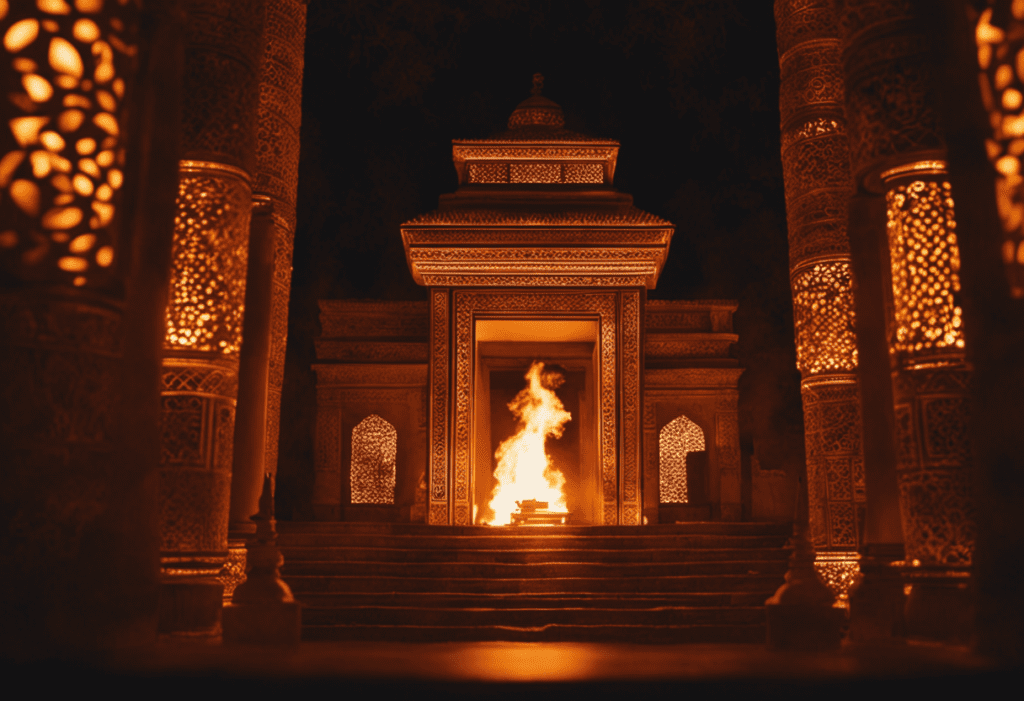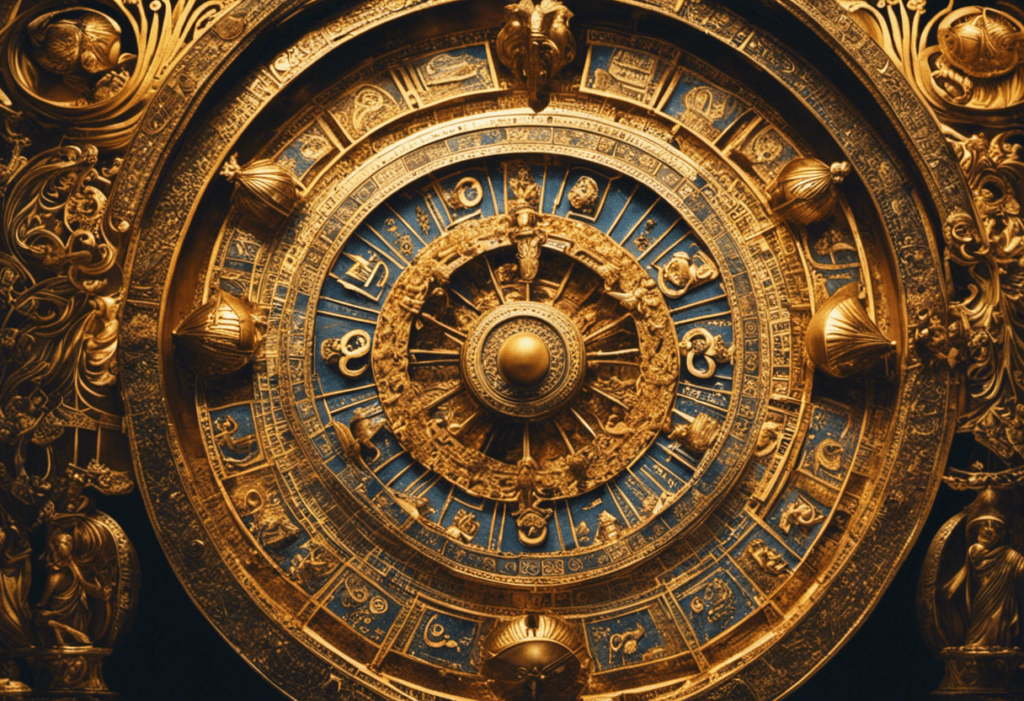In the tapestry of Zoroastrianism, fire temples emerge as timeless symbols, encapsulating the essence of this ancient religion. These sanctuaries, steeped in history, serve as guardians of time, marking the passage of days, months, and years.
By exploring the significance of fire within Zoroastrian beliefs and practices, this article delves into the rituals and ceremonies performed at fire temples. It also examines their role in the observance of festivals and their modern relevance in preserving the rich tapestry of Zoroastrian traditions.
Key Takeaways
- Fire temples serve as accurate timekeepers in the Zoroastrian calendar, symbolizing the eternal nature of time.
- The layout of fire temples is designed to enhance the symbolism of the sacred flame and facilitate its use in tracking time.
- Special chambers and altars are dedicated to different aspects of time, such as daily rituals and important dates.
- Priests are responsible for monitoring the flame and performing rituals to ensure its accuracy as a timekeeper.
Historical Origins of Fire Temples in Zoroastrianism
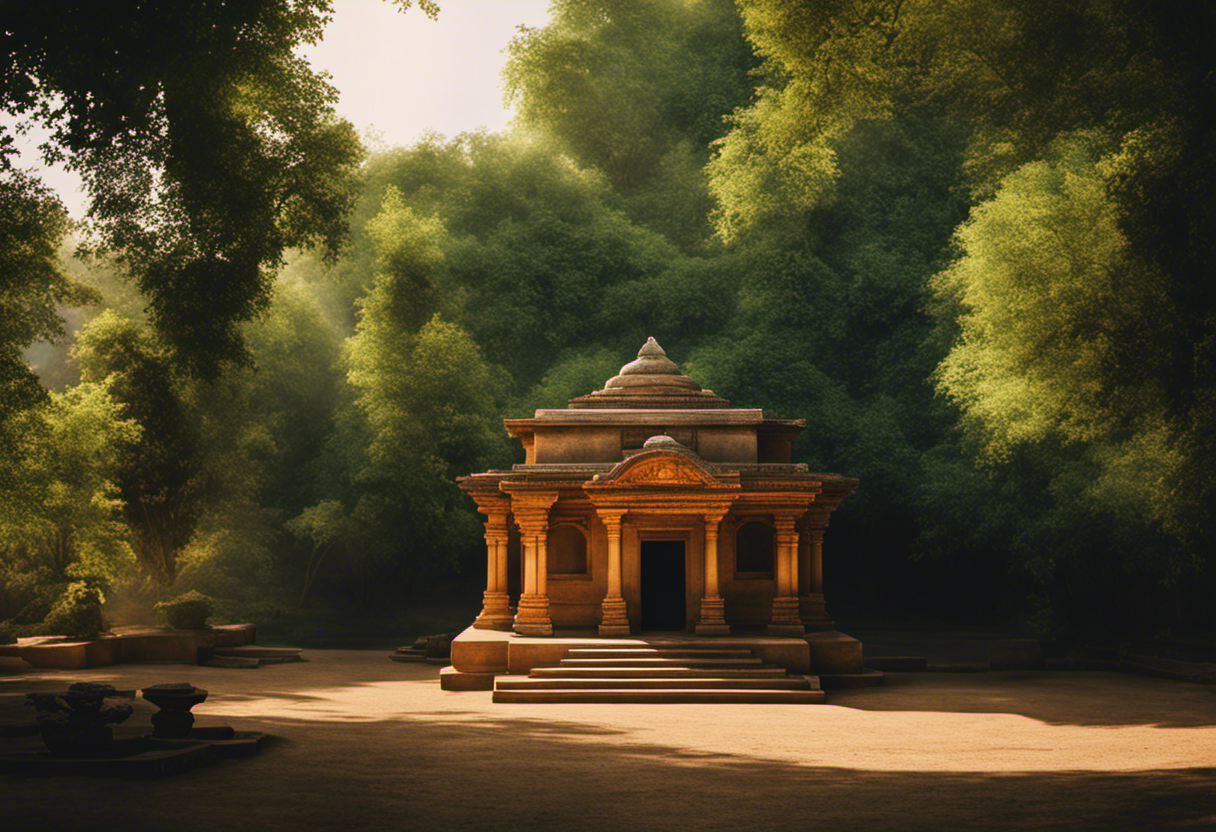

The study explores the historical origins of fire temples in Zoroastrianism through an in-depth analysis of ancient texts and archaeological evidence. Fire temples hold a significant place in the religious practices of Zoroastrianism, serving as sacred spaces where fire is revered and worshiped. The historical development of fire temples can be traced back to ancient Persia, with evidence suggesting that they were established as early as the Achaemenid period, around the 6th century BCE.
Architectural features of fire temples have evolved over time, reflecting both regional variations and changing religious practices. Early fire temples were often simple structures, consisting of a central fire altar and an open courtyard. However, as Zoroastrianism gained prominence and patronage, fire temples became more elaborate and grandiose, with intricate carvings, domes, and minarets adorning their exteriors.
Ancient texts such as the Avesta, the sacred scripture of Zoroastrianism, provide valuable insights into the historical development of fire temples. These texts mention the rituals and ceremonies performed in these sacred spaces, emphasizing the importance of fire as a symbol of purity and divinity.
Archaeological excavations have also unearthed remains of fire temples, providing physical evidence of their existence and architectural features. These findings further support the historical development of fire temples and their significance in Zoroastrianism.
Significance of Fire in Zoroastrian Beliefs and Practices
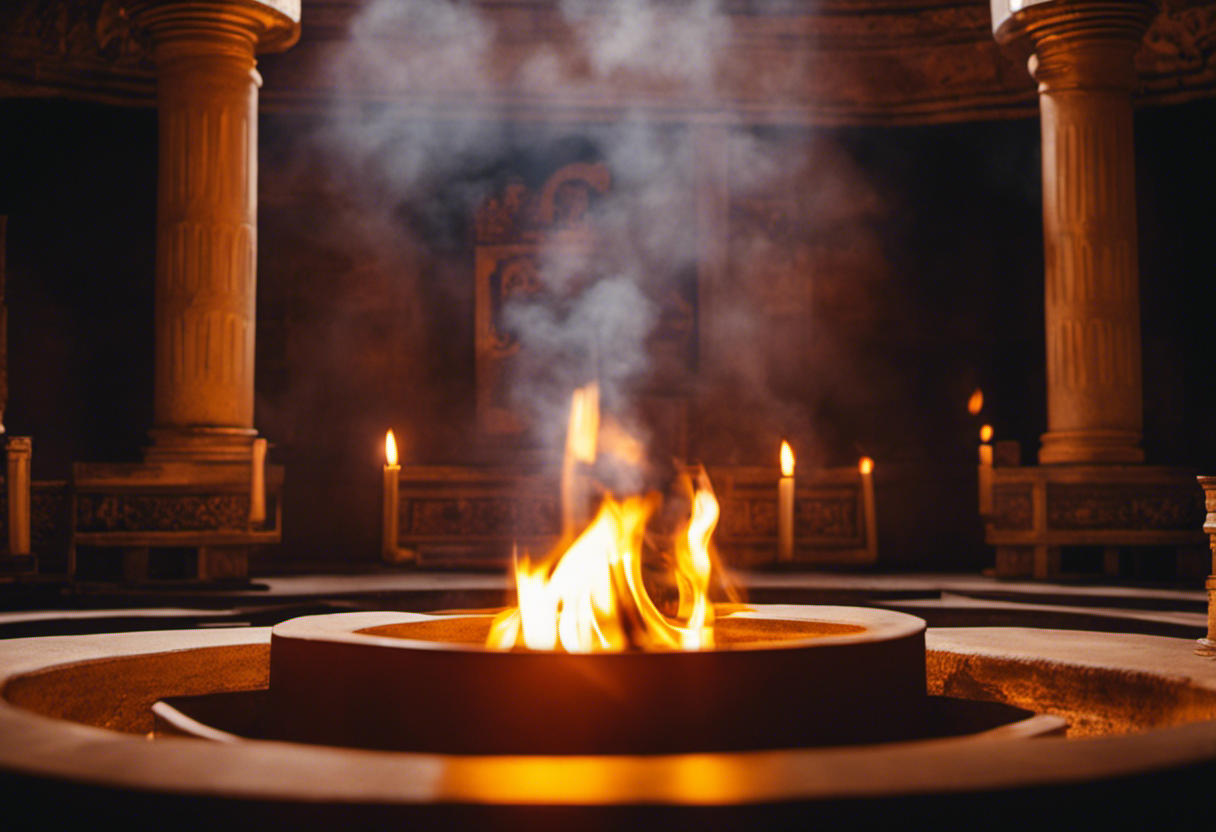

Fire plays a central role in Zoroastrian beliefs and practices, symbolizing purity and divinity, while also serving as a source of illumination and spiritual enlightenment. Zoroastrians believe that fire is a powerful and sacred element that connects them to Ahura Mazda, the supreme deity. Fire temples hold great symbolic importance in Zoroastrianism, serving as places of worship and spiritual rituals.
The significance of fire in Zoroastrian beliefs can be seen through the following aspects:
-
Purity: Fire is believed to possess the power to purify and cleanse. It is considered a symbol of purity and is used in various purification rituals within Zoroastrianism.
-
Divinity: Fire is regarded as a representation of the divine presence of Ahura Mazda. It is seen as a manifestation of his power and wisdom.
-
Illumination: Fire is also seen as a source of light and enlightenment. It is believed to dispel darkness and ignorance, guiding individuals towards spiritual truth and enlightenment.
-
Spiritual rituals: Fire temples are dedicated spaces where Zoroastrians perform religious ceremonies and rituals. These rituals often involve offerings and prayers made to the sacred fire, symbolizing the connection between the worshippers and the divine.
Rituals and Ceremonies at Fire Temples
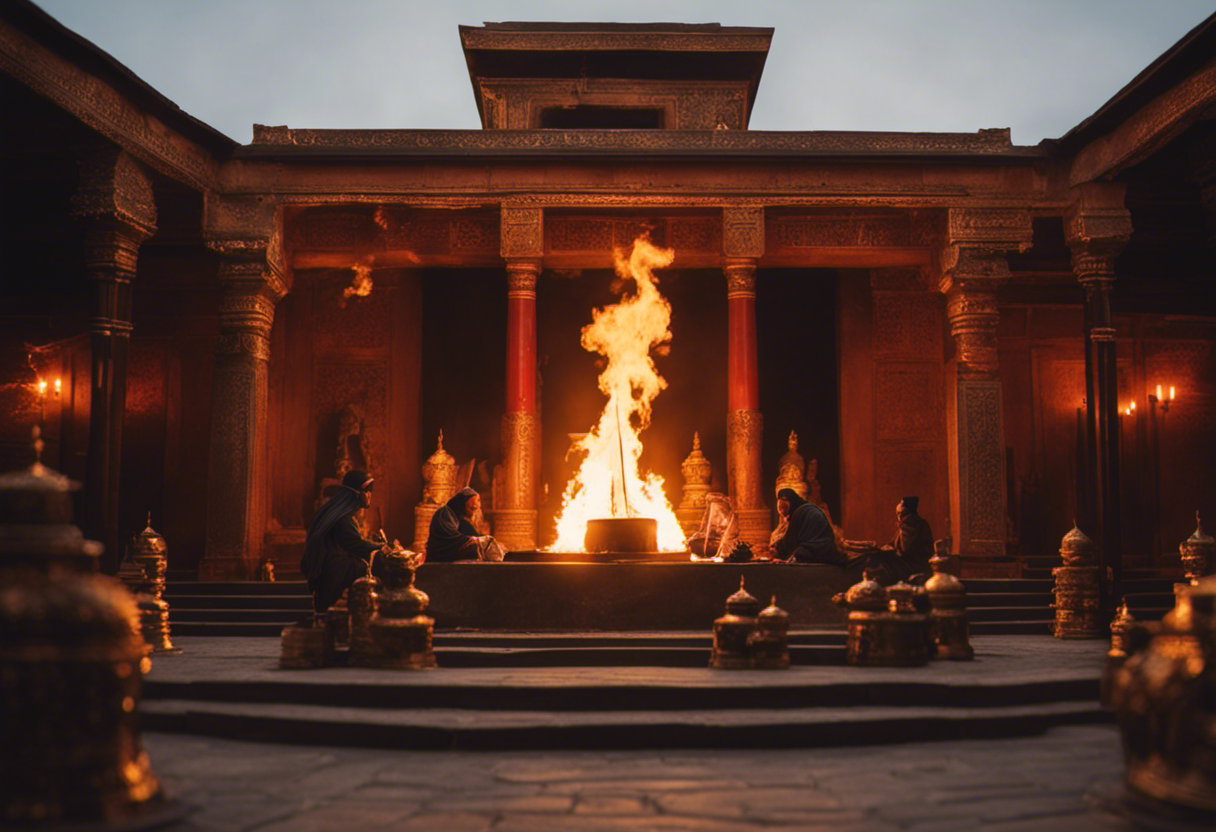

Zoroastrian priests lead and perform various rituals and ceremonies at fire temples, ensuring the proper worship and reverence for the sacred flames. Fire temple architecture plays a crucial role in facilitating these rituals and ceremonies. The design of fire temples is typically characterized by a central chamber, known as the Atashgah, where the sacred fire is kept. This chamber is often elevated to symbolize the divine connection between heaven and earth. The fire is continuously fed with sandalwood and other fragrant substances, creating a peaceful and spiritual atmosphere.
Fire temple rituals are meticulously carried out by the priests to maintain the sanctity of the sacred flames. These rituals include the recitation of prayers, offerings of fruits and flowers, and the performance of sacred dances and hymns. The priests ensure that the fire is constantly attended to and protected from impurities. They are responsible for maintaining the purity of the temple and ensuring that only those who are ritually clean may enter.
The rituals and ceremonies performed at fire temples hold significant importance in Zoroastrianism. They serve as a means of connecting with the divine and seeking blessings for the community. Fire temple architecture and the meticulous execution of rituals help to create a sacred space where worshippers can experience a sense of spiritual transcendence.
Fire Temples as Timekeepers in Zoroastrian Calendar
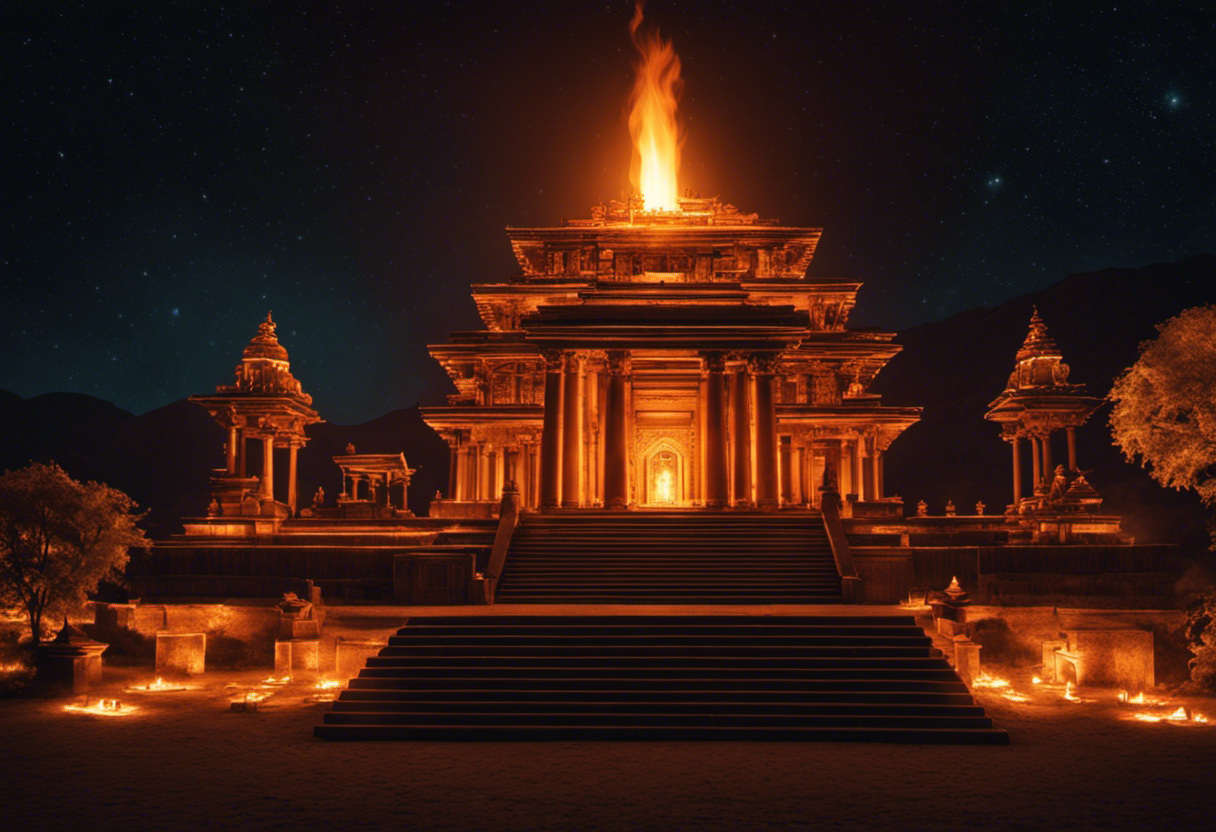

Priests at fire temples utilize the burning flame, a symbol of divine presence, to mark the passage of time in the Zoroastrian calendar, serving as accurate timekeepers. Fire temples play a crucial role in the Zoroastrian community, not only as places of worship but also as centers of timekeeping. The architecture of fire temples is designed to enhance the symbolism of the sacred flame and facilitate its use in tracking time.
The sacred fire is kept burning continuously, symbolizing the eternal nature of time and the divine presence.
The layout of the fire temple is meticulously planned to ensure the proper maintenance and protection of the sacred fire.
Special chambers and altars are dedicated to different aspects of time, such as the daily rituals and the observance of important dates in the Zoroastrian calendar.
Priests are responsible for monitoring the flame and performing the necessary rituals to ensure its accuracy as a timekeeper.
The use of fire as a symbol of time in Zoroastrianism is deeply rooted in the belief that fire is a representation of the divine wisdom and enlightenment. By utilizing fire temples as timekeepers, Zoroastrians honor their religious traditions and maintain a connection with the divine presence in their daily lives.
Fire Temples and the Observance of Zoroastrian Festivals
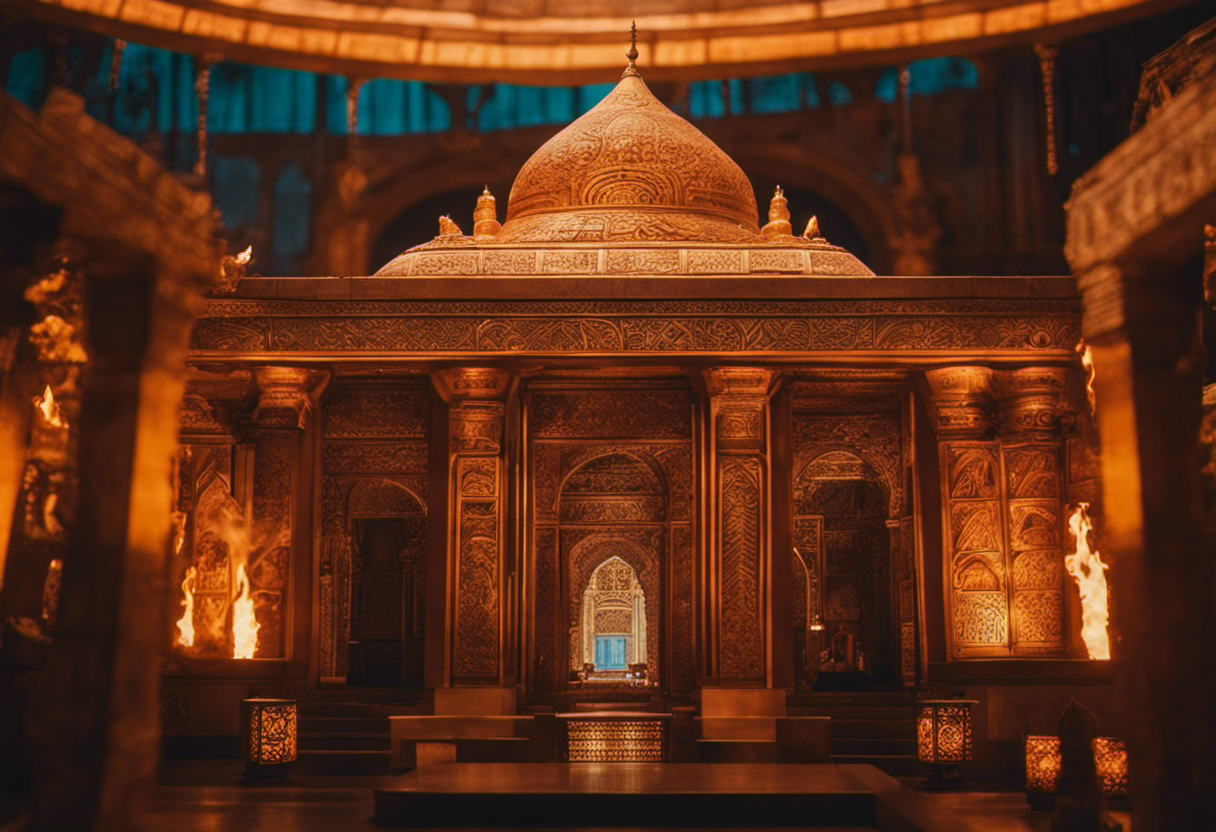

Fire temples play a crucial role in the observance of Zoroastrian festivals, serving as sacred spaces where rituals are performed and prayers are offered. These temples are central to the practice of fire worship, which is a fundamental aspect of Zoroastrianism.
The festivals celebrated in these temples provide opportunities for the community to come together, strengthen their religious bonds, and honor the teachings of their faith.
Fire Temple Significance
There are several key rituals and practices associated with the sacred structures known as fire temples, highlighting their significant role in the observance of important Zoroastrian festivals. Fire temple architecture is meticulously designed to create a space that is conducive to worship and reverence. The symbolism of fire within these temples represents the divine presence and is seen as a medium for spiritual purification and enlightenment.
The current discussion topic focuses on the significance of fire temples in Zoroastrianism. Here are four key points to highlight their importance:
- Fire temples serve as a central hub for the Zoroastrian community, providing a space for communal prayers and religious gatherings.
- The eternal fire, carefully tended by priests, symbolizes the eternal flame of Ahura Mazda, the supreme deity in Zoroastrianism.
- Fire temples play a crucial role in the performance of rituals, including the consecration of sacred fires and the offering of prayers and rituals for various occasions.
- These sacred structures serve as a place of pilgrimage for Zoroastrians, where they can connect with their religious heritage and seek spiritual solace.
Festivals and Fire Worship
Zoroastrian festivals, such as Nowruz and Sadeh, incorporate fire worship practices that are deeply intertwined with the rituals and traditions observed at fire temples.
Fire temples hold great significance in Zoroastrianism, serving as sacred spaces where the eternal flame, representing the divine presence of Ahura Mazda, is kept burning.
The architecture of fire temples is designed to facilitate the rituals and ceremonies associated with fire worship. They often feature a central chamber, known as the dar-e mehr, where the sacred fire is housed and maintained by priests.
The fire is considered a symbol of purity and serves as a focal point for prayer and offerings. During festivals, the sacred fire is further revered and worshipped, with devotees participating in elaborate rituals and ceremonies to honor the divine presence.
These festivals play a crucial role in strengthening the religious identity and fostering a sense of community among Zoroastrians.
Modern Role of Fire Temples in Preserving Zoroastrian Traditions
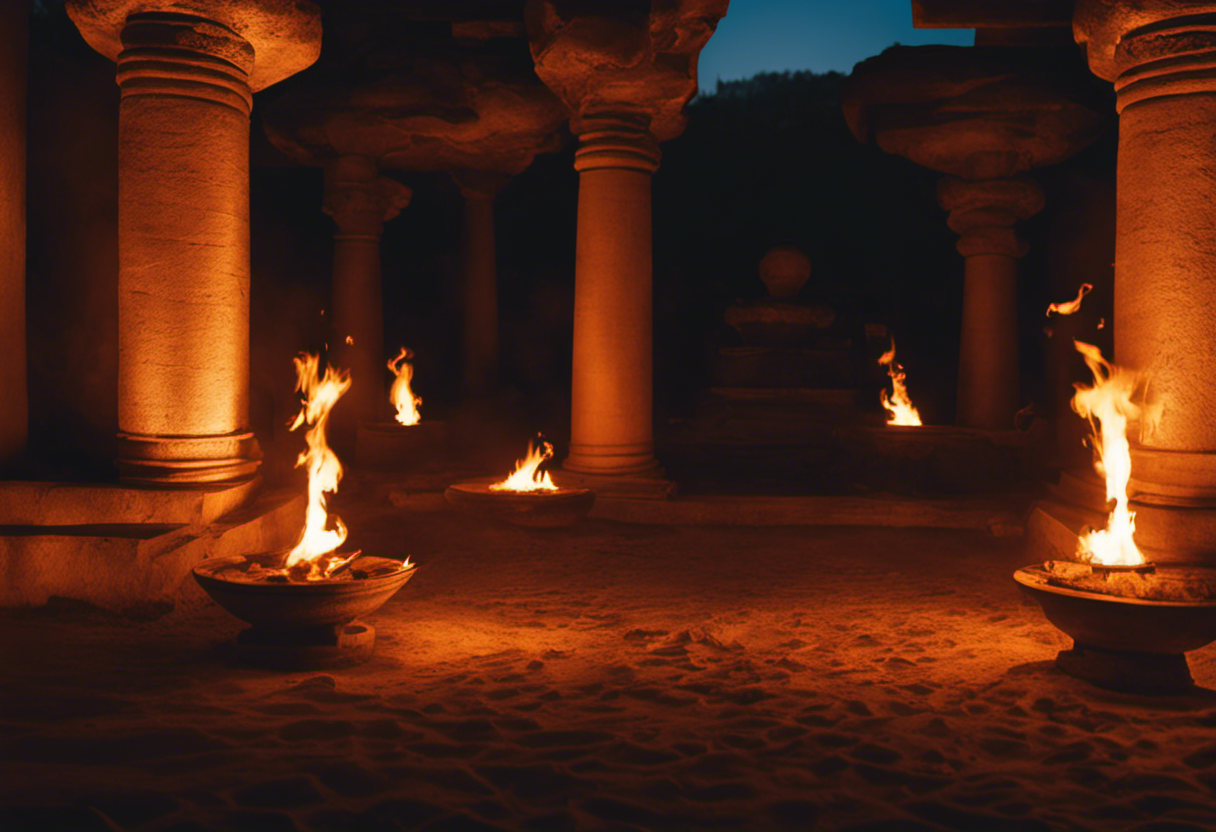

Fire temples have played a crucial role in preserving Zoroastrian traditions in the modern era. These sacred spaces serve as cultural and religious centers where the community gathers to practice rituals and maintain their distinct identity.
Cultural Significance of Fire Temples
Through their architectural design and rituals, fire temples continue to serve as important cultural symbols within the Zoroastrian community, preserving and transmitting ancient traditions. These temples have a significant role in the cultural preservation of Zoroastrianism, as they provide a physical space for religious practices and serve as a gathering place for the community.
The architectural significance of fire temples lies in their unique design, which often includes a central fire altar and a domed structure. This design reflects the central role of fire in Zoroastrianism, symbolizing purity and divine presence. Additionally, fire temples are known for their intricate decorations, highlighting the artistic and aesthetic aspects of the religion.
The rituals performed in fire temples, such as the offering of prayers and the maintenance of the sacred fire, are crucial in maintaining the religious traditions and fostering a sense of belonging within the Zoroastrian community. Fire temples serve as cultural symbols and preserve ancient traditions. The architectural design of fire temples reflects the importance of fire in Zoroastrianism. Fire temples are known for their intricate decorations and aesthetic beauty. Rituals performed in fire temples maintain religious traditions and foster community cohesion.
Zoroastrian Community Preservation
Many Zoroastrian families actively contribute to the preservation of their community’s traditions. They do this by regularly attending fire temple ceremonies and participating in cultural events. The Zoroastrian community places great importance on cultural preservation. They strive to maintain their unique customs and beliefs for future generations.
Fire temples play a crucial role in this endeavor. They serve as sacred spaces where rituals and ceremonies are performed. These temples are not only places of worship but also centers of community gathering and education. They provide a platform for the transmission of knowledge and traditions, ensuring the continuity of Zoroastrian cultural practices.
Conclusion
In conclusion, fire temples have played a significant role in Zoroastrianism as markers of time and the observance of festivals.
Through their rituals and ceremonies, fire temples have served as timekeepers in the Zoroastrian calendar, ensuring the adherence to religious practices and the preservation of traditions.
Despite the modern challenges faced by Zoroastrianism, fire temples continue to serve as important institutions in preserving and safeguarding the rich cultural and religious heritage of the Zoroastrian community.

